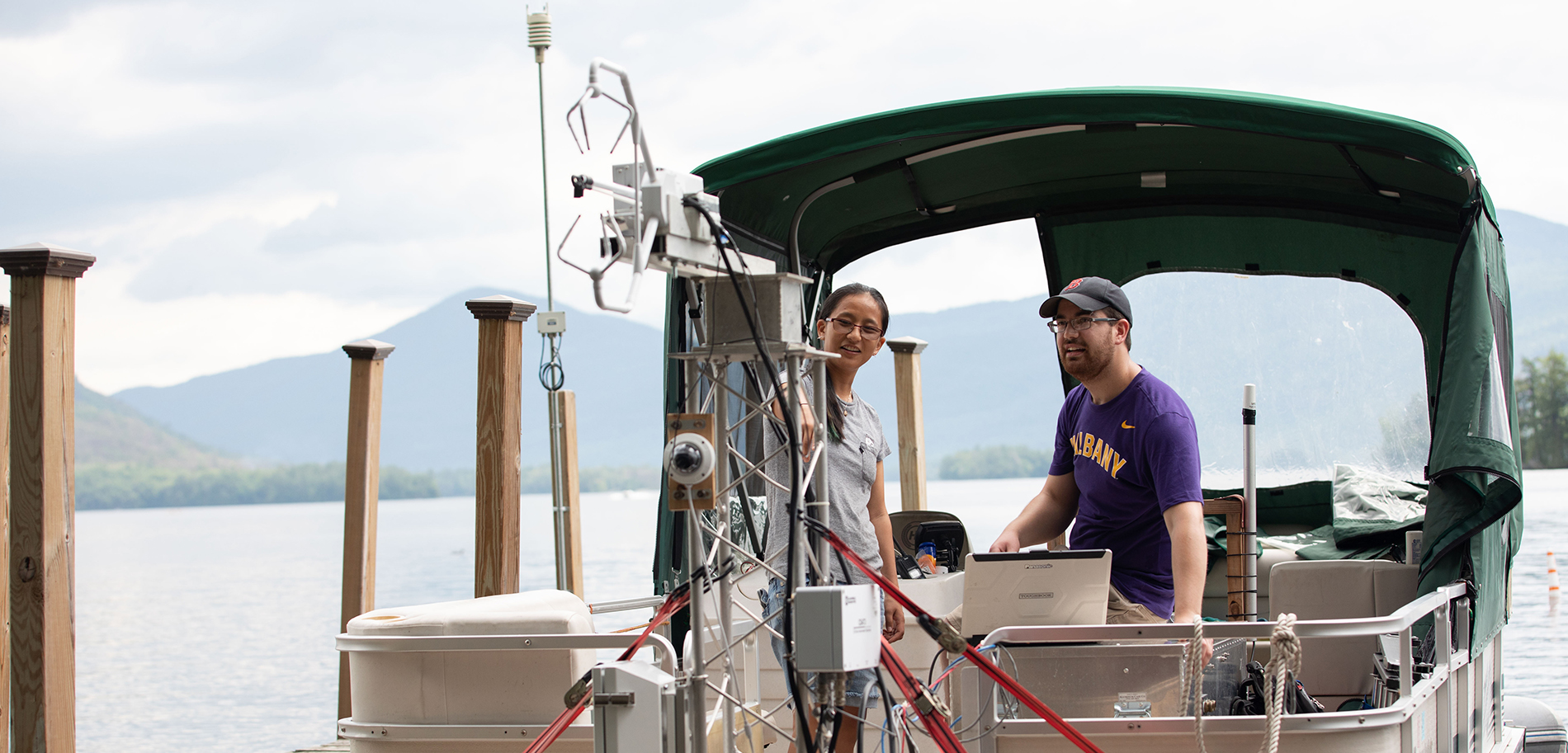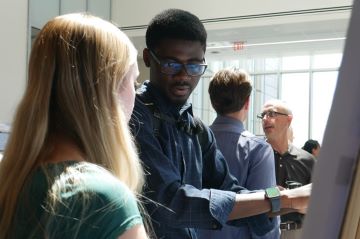
Graduate Research Opportunities
The Atmospheric Sciences Research Center has multiple research opportunities and merit-based fellowships for graduate students applying for Fall 2024 admission.
We encourage you to apply if you are an enthusiastic and motivated student with a BS/MS degree in meteorology, atmospheric science, physics, chemistry, computer science, mathematics or a related field. We also encourage you to apply if you are from an underrepresented or marginalized community.
The application submission deadline for priority review is January 5, 2024. Prospective Graduate Student Visiting Weekend is February 29 - March 2, 2024.
Merit-based Graduate Fellowships
All incoming ASRC-advised doctoral students are eligible to compete for one-year merit-based ASRC Graduate Fellowships that carry a full tuition waiver and stipend.
ASRC's merit-based fellowships for first-year ASRC-advised doctoral students includes full tuition (9 credits per semester) and a research assistantship stipend for a 12-month period. Pending satisfactory academic performance, successful applicants can expect comparable support levels in subsequent years. All first-year doctoral students, domestic and international, interested in being advised or co-advised by an ASRC faculty member are eligible to apply. To receive full consideration for the fellowship, you must submit:
- An application for admission to the appropriate University at Albany Doctoral Program,
- A letter requesting fellowship consideration to the ASRC Graduate Fellowship Committee, c/o Dr. Fangqun Yu, [email protected]. The letter of request should be a one page cover letter alerting the committee of the applicant’s research interests and the potential ASRC advisor(s) identified.
You are strongly encouraged to coordinate your application with a faculty member at ASRC prior to submission. We may consider late applications under special circumstances.
Graduate Research Assistantship and Teaching Assistantship
There are many graduate student research opportunities within ASRC and the Department of Atmospheric and Environmental Sciences.
Teaching Assistantship
Eligible students can apply for a teaching assistantship. You should indicate you are interested in a teaching assistantship when you submit your application.
Opportunities for individuals from underrepresented groups
If you are an individual from an underrepresented group, we encourage you to contact ASRC faculty members about research opportunities. You may find other opportunities through university or external diversity fellowship programs that will allow you to work with a faculty member to craft a unique research project.
You can email individual faculty members with whom you are interested in working or contact Dr. Jorge González-Cruz ([email protected]), Chair of ASRC's Diversity and Inclusion Committee, for more information.
Current Opportunities
NOAA Cooperative Science Center in Atmospheric Sciences and Meteorology (NCAS-M) Graduate Student Fellowship
ASRC hopes to recruit 1-2 underrepresented minority students for two-year NCAS-M Graduate Student Fellowships for the Fall 2024 semester, pending availability of funding. You are encouraged to apply if you are a:
- Graduate student with minimum 3.0 GPA in an academic major that aligns with NOAA’s mission including atmospheric sciences and other STEM and/or social sciences;
- U.S. citizen.
There are several benefits to becoming a fellow, including:
- Two-year financial support - full tuition and annual minimum stipend of $27,500 for doctoral students
- Training in NOAA-mission research and applications
- Mentorship and engagement with NOAA professionals
- Professional skills development workshops
Research Areas and Faculty Advisors
ASRC Graduate research students have access to a variety of tools and areas to work with in addition to faculty members to advise them. The following research activities can help guide you to find an ASRC advisor.
- Development of forecast tools for power outage prediction, improving wind and solar power production forecasting, the effects of climate change on renewable energy resources, and the interaction of wind farms (and their performance) with the atmospheric boundary layer processes (Dr. Freedman)
- Ground- and satellite-based remote sensing to investigate vegetation-planetary boundary layer interactions, and/or improve subseasonal-to-seasonal hydrologic prediction
- Development of an autonomous, buoy-based system for measuring air-sea interaction from the sea surface to the top of the marine atmospheric boundary layer (Dr. Miller, Dr. Freedman)
- Coastal-urban systems; modeling, observations, and applications to: weather; climate; energy and air quality (Dr. J. González-Cruz)
- Dynamics of African easterly waves and their interactions with Saharan Dust Aerosols (Dr. Thorncroft, Dr. Grogan, Dr. Lu)
- Utilizing data from a new, densely-distributed network of low-cost air quality sensors deployed in the New York City metropolitan area to determine spatial and temporal patterns, source attribution, and compare measurements with models (Dr. Lu, Dr. Miller)
- Using data from ground-based surface-atmosphere exchange networks (e.g., New York State Mesonet at regional scale, Ameriflux/Fluxnet at continental/global scale) to evaluate land surface models, land-atmosphere coupling, and planetary boundary layer schemes (Dr. Miller, Dr. Lu)
- Developing machine-learning models and employing statistical techniques to study variations and sensitivities among climate regions and their influence on predictability as well as to investigate the predictability of winter-weather effects on NY state roadways (Dr. Sulia, Dr. Thorncroft)
- Fundamentals of particle formation and evolution, aerosol-cloud-precipitation-climate interactions, solar radiation management, contrail formation and impact of hydrogen fuel aircraft, health effects of particles in the atmosphere (Dr. Yu, Dr. Lance)
Frederick Boakye Oppong

I am currently pursuing a PhD in Atmospheric Science, with research on understanding extreme heat events in Caribbean islands using observations and high-resolution urbanized climate models and examining how these events may manifest under different warming climate scenarios.
My area of specialty is atmospheric physics and climate dynamics, focusing on the physical processes that determine the Earth's weather and climate system and how it changes over time.
My passion for atmospheric sciences began in high school when a teacher shared a story about the Earth’s formation and its early state without an atmosphere. That moment sparked my curiosity: How did the atmosphere form? What is it composed of? How does it shape life on our planet? Since then, I’ve been fascinated by atmospheric processes and committed to exploring how changes in the atmosphere influence weather, climate and the environment.
I aspire to be a leading voice in regional and global climate dynamics and change, producing actionable science that bridges the gap between research and societal needs. I want my work to directly inform decision-making, especially for climate-vulnerable communities.
I was honored to receive the Student Presentation Award at the 38th Conference on Climate Variability and Change during the 2025 AMS Annual Meeting in New Orleans. My poster, “Climatology and Large-Scale Drivers of Extreme Heatwaves in the Caribbean: From 1971 to 2020”, earned First Place Poster Presentation recognition. This achievement inspires me to continue striving for excellence and contributing meaningfully to atmospheric science.
I hope to advance our understanding of extreme heat and climate extremes in coastal-urban regions. I aim to unravel the mechanisms driving these events, including the influence of large-scale circulation patterns, local meteorology and coastal-urban coupling. I seek to improve our ability to predict extreme events and better anticipate their impacts. Ultimately, my goal is to protect lives, support communities and safeguard our planet by developing science-based frameworks that inform policy decisions, strengthen resilience and enhance preparedness in small island environments.
I encourage anyone who is just starting their academic career in the sciences to stay curious, stay persistent and never underestimate the power of your questions. Science thrives on curiosity and perseverance. Every discovery starts with a simple question, so keep asking, keep exploring and believe that your passion can drive meaningful change in the world.


